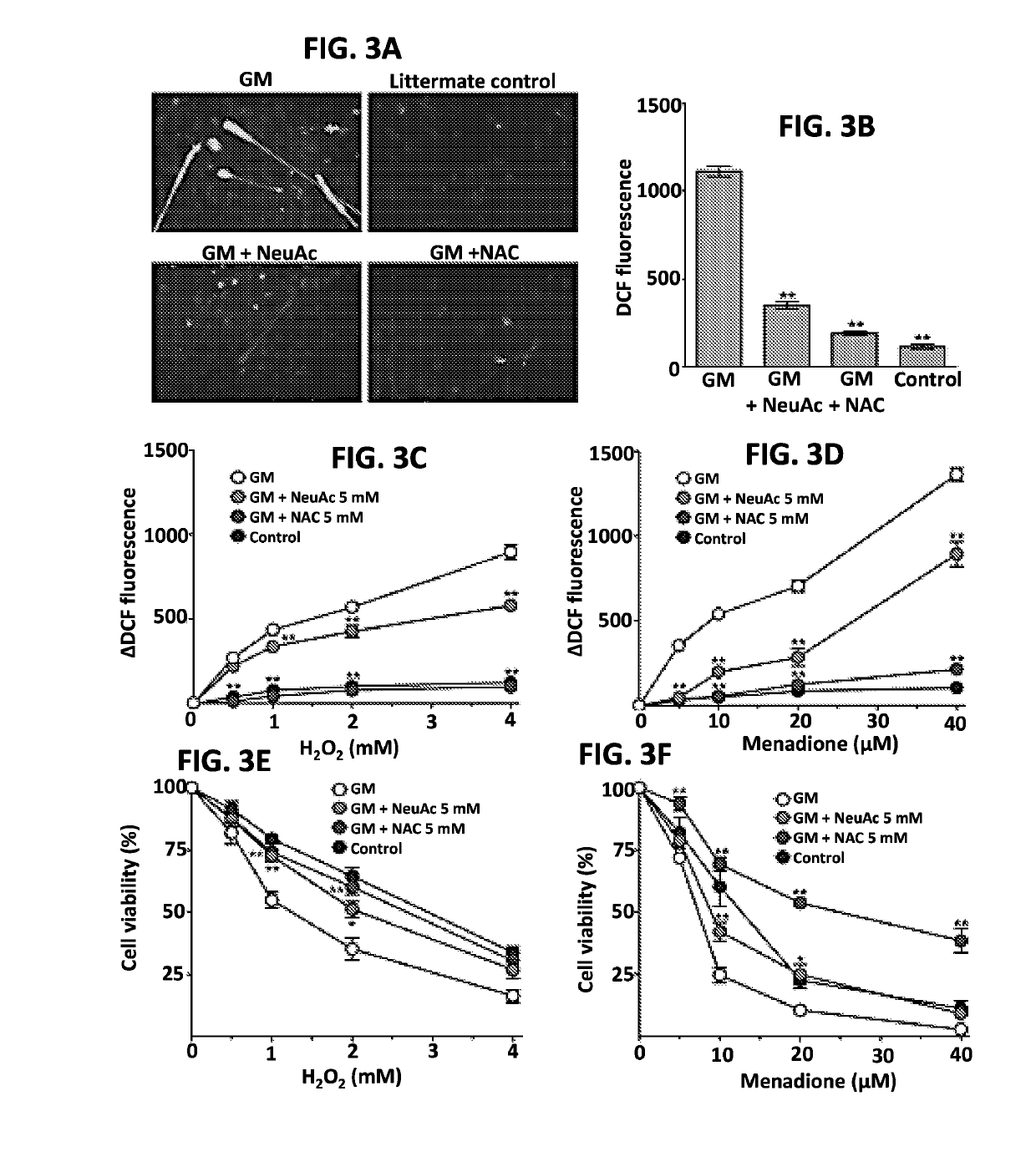Sialylation-increasing therapies for diseases associated with oxidative stress
a technology of oxidative stress and increasing therapies, applied in the direction of microcapsules, drug compositions, cardiovascular disorders, etc., can solve the problems of damage to proteins, lipids, nucleic acids, etc., and achieve the effect of improving cardiac function
- Summary
- Abstract
- Description
- Claims
- Application Information
AI Technical Summary
Benefits of technology
Problems solved by technology
Method used
Image
Examples
example 1
Materials and Methods
[0178]Mice: Generation of Gne-knockout mice that express the human GNE mutation D176V (Gne− / −hGNED176V-Tg) was described previously (Malicdan et al., Hum Mol Genet. 2007; 16:2669-2682). Same line of GNE Myopathy mice (Gne− / −-hGNED176V-Tg) and littermate mice (Gne+ / −hGNED176V-Tg) as controls were used throughout the study.
[0179]Quantitative RT-PCR and microarray analysis: Total RNA was extracted from triceps brachii muscles using TRIZOL® reagent and subsequently treated with DNase I (Invitrogen). cDNA was synthesized using SUPERSCRIPT® VILO™ cDNA Synthesis Kit (Invitrogen).
[0180]Microarray experiments were carried out using a CODELINK™ Mouse Whole Genome Bioarray (Applied Microarrays Inc.) at Filgen Inc. The arrays were scanned using a GENEPIX®4000A Array Scanner (Molecular Devices Inc.). The data were analyzed by using Microarray Data Analysis Tool version 3.2 (Filgen Inc.).
[0181]For quantitative PCR, TAQMAN® probes were used in combination with the TAQMAN® Gene...
example 2
Atrogins and Oxidative Stress Related Genes are Upregulated in the GNE Myopathy Muscles
[0192]Two muscle-specific ubiquitin ligases, atrogin-1 / FBxo32 and MuRF1 / Trim63, are upregulated in various models of muscle atrophy (Bodine et al., Science Signaling. 2001; 294:1704; Gomes et al., Proc Natl Acad Sci USA. 2001; 98:14440-14445). Quantitative RT-PCR revealed these two skeletal muscle atrophy markers are highly expressed with a 1.8-fold increase in atrogin-1 expression and a 2.0-fold increase in MuRF1 in Gne− / −hGNED176V-Tg mice (n=17, 58.0±0.2 wk) muscles as compared to littermates (n=6, 57.9±0.2 wk) muscles (FIG. 1A). These results are in line with myopathic phenotypes in model mice (Malicdan et al., Physiol Genomics. 2008; 35:106-115) and suggest that common proteolytic systems of muscle atrophy are involved in the pathomechanism of GNE Myopathy.
[0193]In order to determine the pathologic pathways related with loss of GNE function, the expression of genes expected to be deregulated i...
example 3
Oxidative Stress is Increased in GNE Myopathy Muscles
[0195]To directly establish that oxidative stress is associated with the pathomechanism of GNE Myopathy, the levels of ROS was analyzed in skeletal muscles in vivo (FIG. 2). Baseline hydroxyl radicals in microdialysate from resting muscles were similar in both GNE Myopathy mice (2.3±0.8 pM; n=9) and littermates (2.4±1.2 pM; n=5). Then ROS production ws monitored during and after muscle contraction by electrical stimulation of gastrocnemius muscles; considerable increases of hydroxyl radicals after muscle contraction were found. Notably, the degree of ROS increments was significantly greater in GNE Myopathy mice (14.5±8.8 pM) than those in littermates (6.3±2.8 pM; p<0.05) (FIGS. 2, C and D), implying oxidative stress is indeed increased in the affected muscles.
PUM
| Property | Measurement | Unit |
|---|---|---|
| diameter | aaaaa | aaaaa |
| weight | aaaaa | aaaaa |
| thickness | aaaaa | aaaaa |
Abstract
Description
Claims
Application Information
 Login to View More
Login to View More - R&D
- Intellectual Property
- Life Sciences
- Materials
- Tech Scout
- Unparalleled Data Quality
- Higher Quality Content
- 60% Fewer Hallucinations
Browse by: Latest US Patents, China's latest patents, Technical Efficacy Thesaurus, Application Domain, Technology Topic, Popular Technical Reports.
© 2025 PatSnap. All rights reserved.Legal|Privacy policy|Modern Slavery Act Transparency Statement|Sitemap|About US| Contact US: help@patsnap.com



